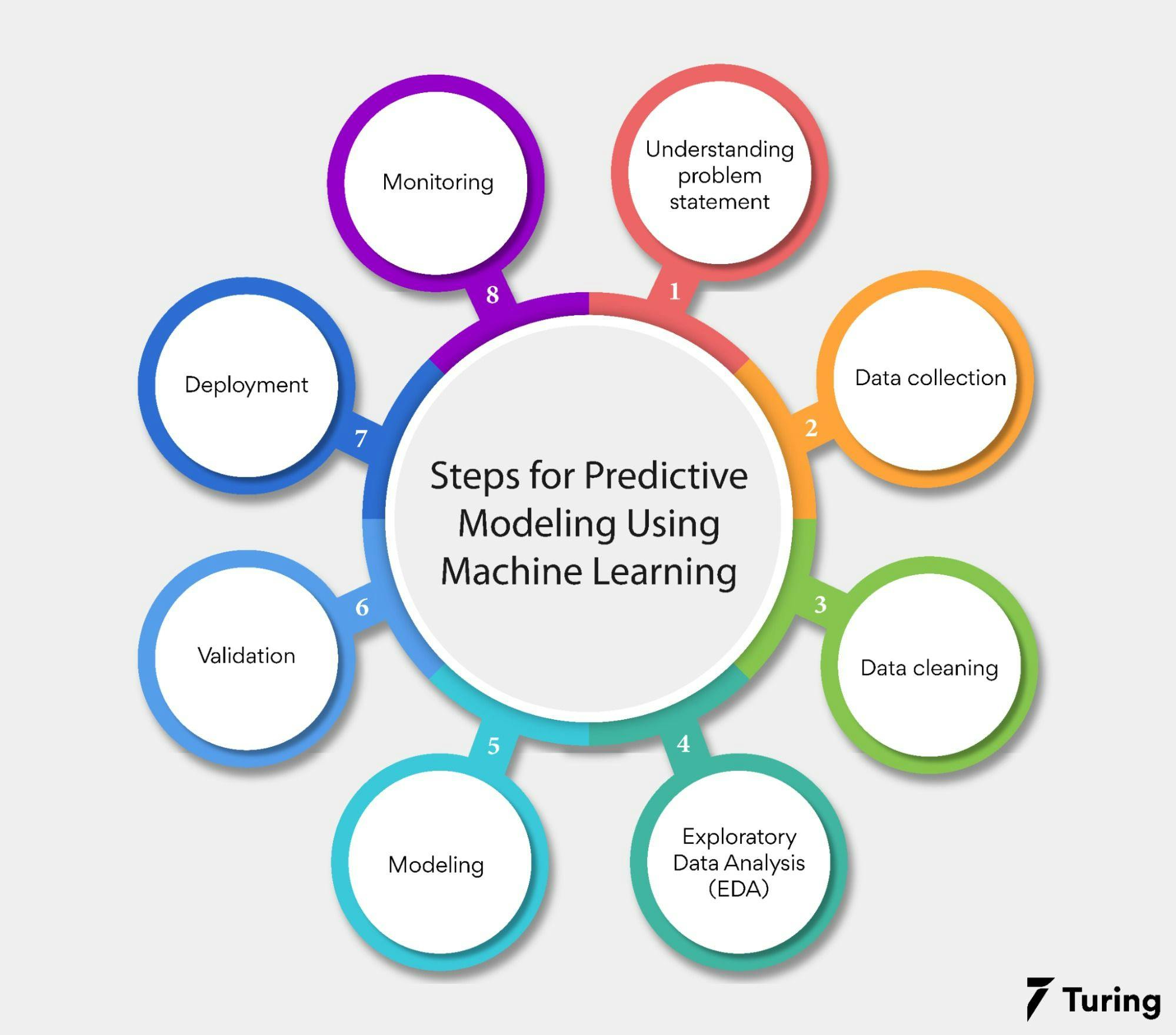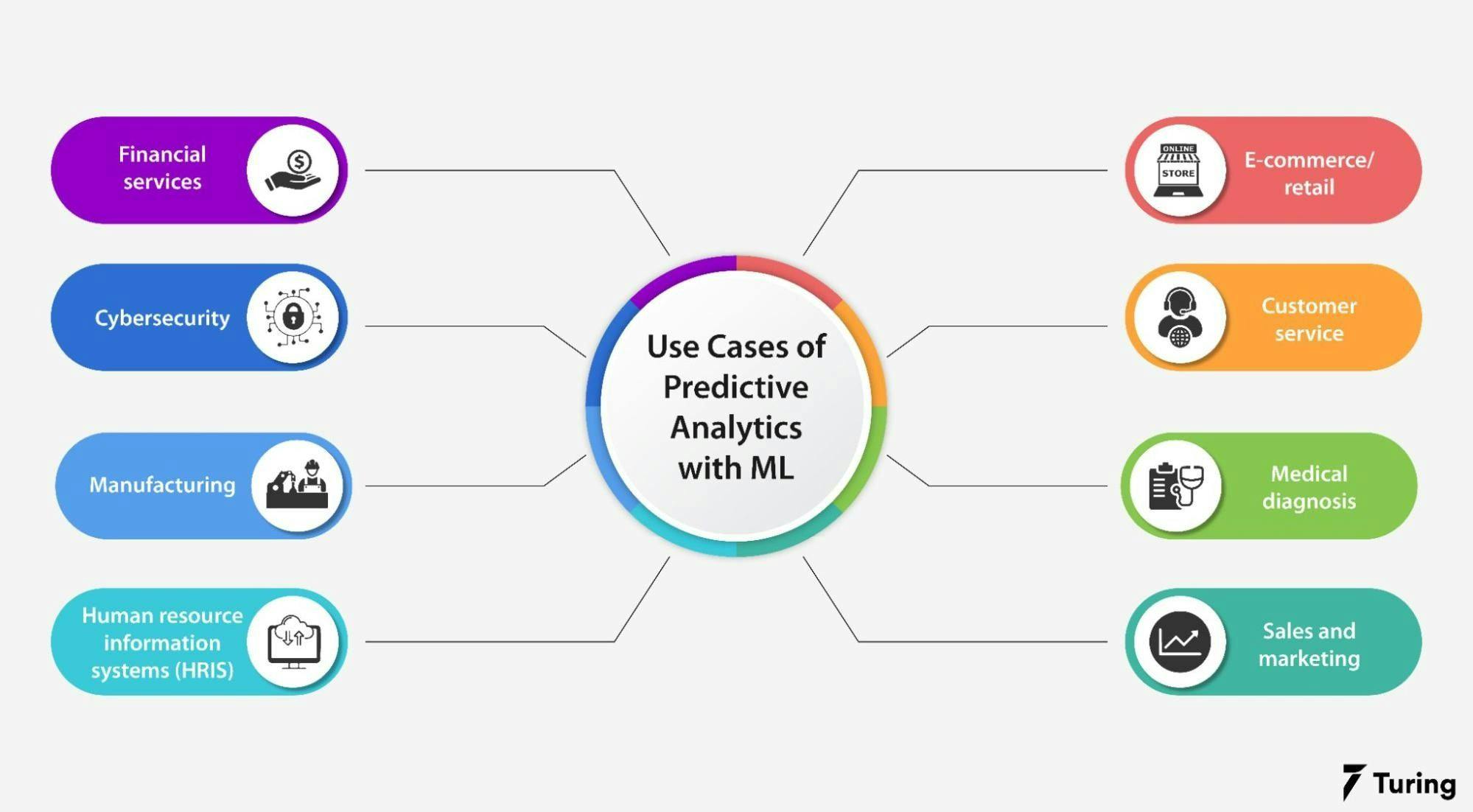How Can You Improve Your Predictive Analytics With ML?
•7 min read
- Languages, frameworks, tools, and trends

Predictive analytics using machine learning (ML) involves two steps: building a model and refining it. This cycle is repeated multiple times until the best model is created and then deployed. In this article, we will explore how we can improve predictive analytics with ML in order to derive highly effective insights.
An overview of predictive analytics using machine learning
Predictive analytics is a powerful technique that ‘predicts’ the future, in a sense. It can help answer key questions, such as how many products a business could sell in the next three months and how much profit it is likely to make.
Using sales as an example, it’s essential to know past sales data in order to predict future sales. The past sales data and cleaned data from descriptive analytics are mixed to create a dataset to train an ML model.
The built model predicts future sales, say, for the next few months. The predicted quantities sold and profits made are compared with the actual numbers sold and profits made. The actual profits could be more or less than what was predicted. The model is refined to overcome such limitations and improve the accuracy of predictions.
Types of analytics
There are four types of analytics: descriptive, diagnostic, predictive, and prescriptive.
- Descriptive analytics deals with the cleaning, relating, summarizing, and visualizing of given data to identify patterns.
- Diagnostic analytics deals with analyzing why something is happening. For example, investigating the reason behind the decline or growth of revenue.
- Predictive analytics involves predicting future outcomes or unknown events using machine learning and statistical algorithms.
- Prescriptive analytics uses descriptive and predictive sources to assist with decision-making.
There are many scenarios where there may be an abundance of data. However, there may be no algorithms available to train machines to perform certain tasks. In this case, we want the machines to learn from the data and apply the learning to unseen inputs. This is referred to as machine learning. For example, if we want to know employee churn rate, we can use a machine learning model that has been trained on past data to predict if an employee will leave.
ML is used when we cannot explicitly estimate all the possible cases of an event occurring and write a piece of code for each. For example, what are the rules to predict if content posted on a video-hosting platform is for kids or adults? How do we predict the genre of a new show? There are millions of videos uploaded every day. Examining and analyzing each of them manually is impossible. This is where ML comes into play as the algorithms can process enormous amounts of structured (data in rows and columns) and unstructured (images, videos, text with emoticons, etc.) data.
Steps for predictive analytics using machine learning

There are eight steps to perform predictive analytics with ML.
Step 1: Define the problem statement
We begin by understanding and defining the problem statement, and deciding on the required datasets on which to perform predictive analytics.
Example: There is a grocery store. Our objective is to predict the sales of groceries for the next six months. Here, past sales data of how many groceries were sold and the resulting profits of the last five years will be the dataset.
Step 2: Collect the data
Once we know what sort of dataset is needed to perform predictive analytics using machine learning, we gather all the necessary details that constitute the dataset. We need to ensure that the historical data is collected from an authorized source.
Using the grocery store example, we can ask the accountant for records of past sales logged in worksheets or billing software. We collect data spanning the past five years.
Step 3: Clean the data
The raw dataset obtained will have some missing data, redundancies, and errors. Since we cannot train the model for predictive analytics directly with such noisy data, we need to clean it. Known as preprocessing, this step involves refining the dataset by eradicating unnecessary and duplicate data.
Step 4: Perform Exploratory Data Analysis (EDA)
EDA involves exploring the dataset thoroughly in order to identify trends, discover anomalies, and check assumptions. It summarizes a dataset’s main characteristics. It often uses data visualization techniques.
Step 5: Build a predictive model
Based on the patterns observed in step 4, we build a predictive statistical machine learning model, trained with the cleaned dataset obtained after step 3. This machine learning algorithm helps us perform predictive analytics to foresee the future of our grocery store business. The model can be implemented using Python, R, or MATLAB.
- Hypothesis testing
Hypothesis testing can be performed using a standard statistical model. It includes two hypotheses, null and alternate. We either reject or fail to reject the null hypothesis.
Example: A new ‘buy one, get one free’ scheme is implemented where customers buy a packet of soap and get a face wash for free. Consider the two cases below:
Case 1: Despite the scheme, sales of soap did not improve.
Case 2: After the scheme, sales of soap improved.
If the first case is true, we fail to reject the null hypothesis as there is no improvement. If the second case is true, we reject the null hypothesis.
Step 6: Validate the model
This is a crucial step wherein we check the efficiency of the model by testing it with unseen input datasets. Depending on the extent to which it makes correct predictions, the model is retrained and evaluated.
Step 7: Deploy the model
The model is made available for use in a real-world environment by deploying it on a cloud computing platform so that users can utilize it. Here, the model will make predictions on real-time inputs from the users.
Step 8: Monitor the model
Now that the model is functioning in the real world, we need to verify its performance. Model monitoring refers to examining how the model predicts actual datasets. If any improvement must be made, the dataset is expanded and the model is rebuilt and redeployed.
How machine learning improves predictive analytics

Predictive analytics continues to be improved with machine learning algorithms. The eight use cases discussed below illustrate how.
E-commerce/retail
Predictive analytics achieved through machine learning helps retailers understand customers’ preferences. It works by analyzing users’ browsing patterns and how frequently a product is clicked on in a website. For example, when we purchase a t-shirt on an e-commerce site, similar shirts are suggested the next time we log in. Sometimes, we may be recommended several specific items that are often purchased together for x amount of money. Such personalized recommendations help retailers retain customers. Predictive analytics also helps maintain inventory by foreseeing and informing sellers about stockouts.
Customer service
Customer segmentation is performed based on insights by predictive analytics. Customers are placed into different segments depending on their purchase patterns. For example, book buyers will form one cluster while t-shirt buyers will constitute another. Tailored marketing strategies are then developed for each of the segments depending on their characteristics.
Predictive analytics using machine learning can also detect dissatisfied customers and help sellers design products aimed to retain existing customers and attract new ones.
Medical diagnosis
Machine learning models that are trained on large and varied datasets can study patient symptoms comprehensively to provide faster and more accurate diagnoses. Performing predictive analytics on the reasons behind past hospital readmissions can also improve care.
Further, hospitals can use predictive analytics to provide the best care by pre-determining increase of hospital bed availability or staff shortage. For example, if the number of COVID cases for the next month can be predicted and the rise in the number of severely infected can be forecasted, hospitals can make arrangements to deal with such a scenario more efficiently.
Sales and marketing
Predictive analytics of historical data of customer behavior and market trends can help businesses understand the demands of prospective customers. Companies can achieve higher targets by streamlining their sales and marketing activities into a data-based undertaking. Demand forecasting also helps businesses estimate the demand for certain products in the future.
Financial services
Predictive analytics using machine learning helps detect fraudulent activities in the financial sector. Fraudulent transactions are identified by training machine learning algorithms with past datasets. The models find risky patterns in these datasets and learn to predict and deter fraud.
Cybersecurity
Machine learning algorithms can analyze web traffic in real-time. When an unusual pattern is observed, advanced statistical methods of predictive analytics foresee and prevent cyber-attacks. They also automatically collect attack-related data and generate useful reports on a cyber-attack, thereby reducing the need for manpower.
Manufacturing
Machine learning and predictive analytics help manufacturers monitor machines and notify them when crucial components need to be repaired or replaced. They can also predict market fluctuations, reduce the number of accidents, improve key performance indicators (KPIs), and enhance overall production quality.
Human Resource Information Systems (HRIS)
Predictive analytics using machine learning identifies employee churn rate and keeps human resources (HR) departments informed of the same. Models can be trained with datasets that have details such as an employee's monthly income, allowances, increments, insurance, and so on. The models learn from past records of ex-employees and find patterns to understand the reasons for leaving. They then predict if new employees are likely to resign or not, empowering HR to minimize the risk.
Thanks to the development of software systems supported by predictive analytics and backed by ML, one-click forecasting has been fulfilled. However, there are certain challenges that need to be overcome. These include preparing and processing the right dataset, finding experienced professionals to deploy predictive models, the high cost of predictive analytics software and data processing, and the need to upgrade to newer ML algorithms due to the evolution of the technology.
Author
Turing Staff